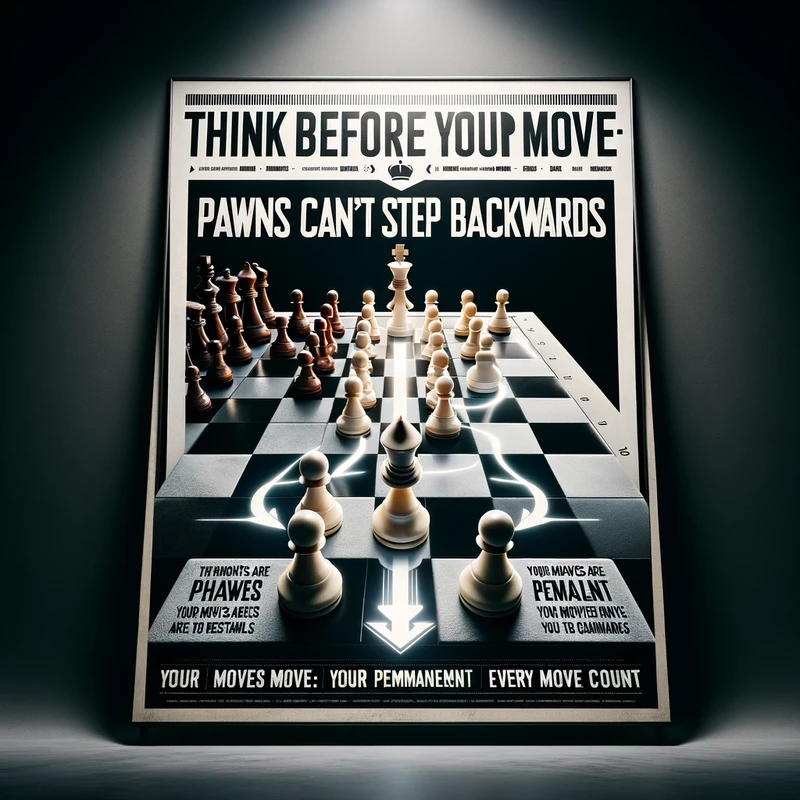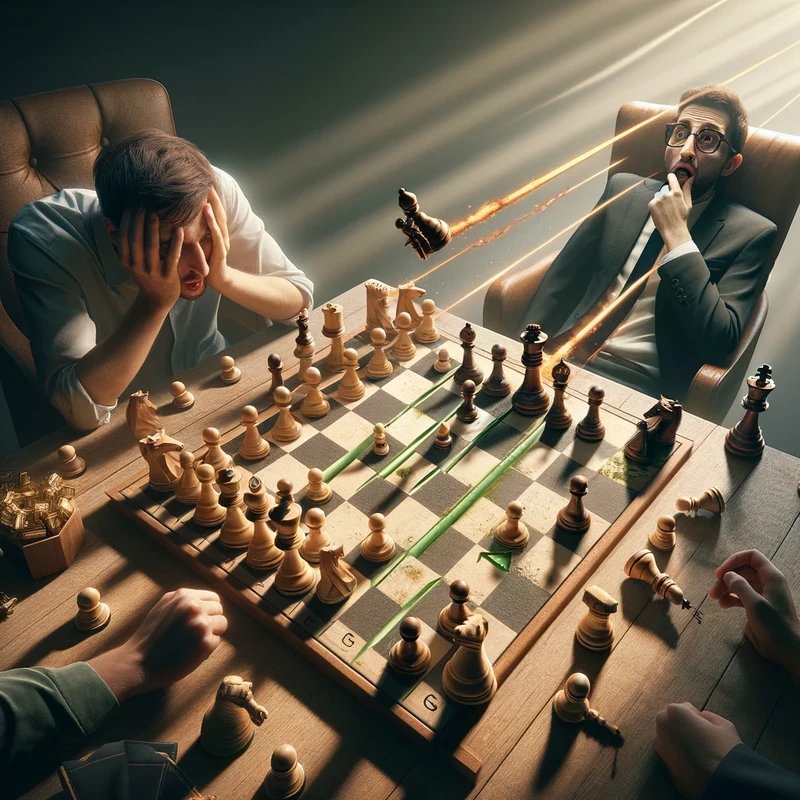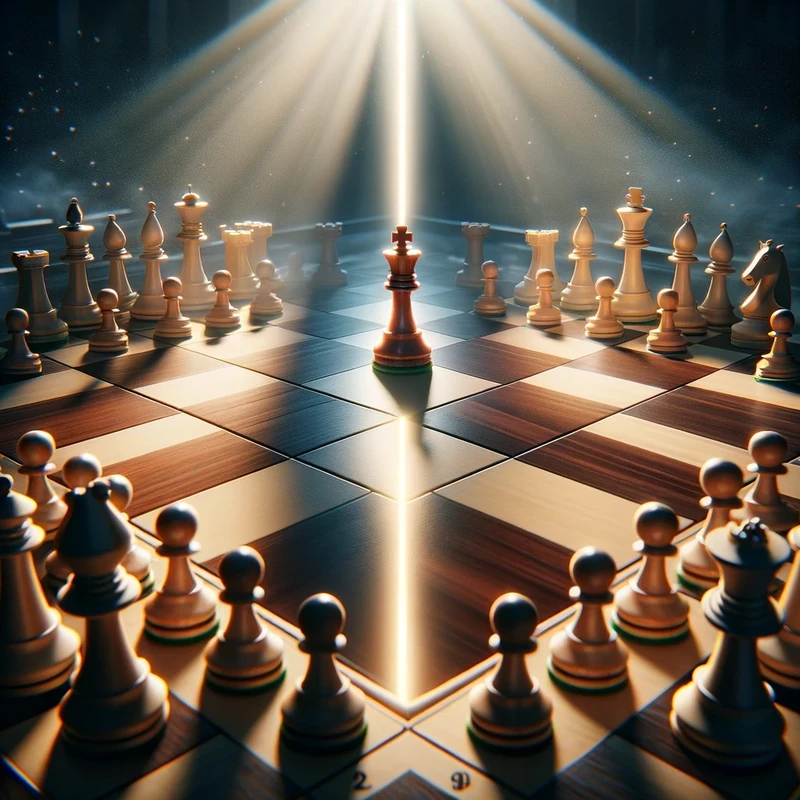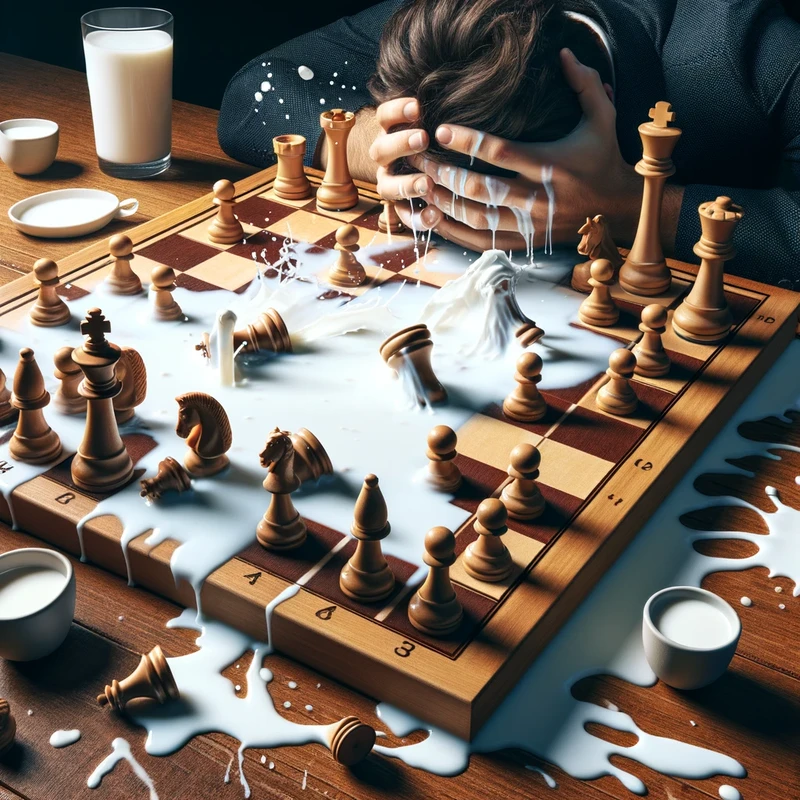
AI generated
Supercharge Your Chess Tactics by Punishing Mistakes
Mistakes are what makes chess fun especially at lower levels. We need to be really good at punishing mistakes. This blog has some tips for doing so from my recent analysis of games of Alexander Alekhine that were 26 moves or less. .Hi all
When I did a course on Mikhail Tal focusing on his shorter and sweeter wins, I thought it was like the chess equivalent of going on very hot dates. Hugely entertaining, and I found my capabilities for noticing soft spots around the King was amplified greatly in particular. It seems Mikhail Tal's opponents also caught on to King soft spots where the King is the only defender and remarked in later years:
"It's funny, but many people don't understand why I draw so many games nowadays. They think my style must have changed but this is not the case at all. The answer to this drawing disease is that my favorite squares are e6, f7, g7 and h7 and everyone now knows this. They protect these squares not once but four times!" - Mikhail Tal
Themes we can use - and not so much about History

So my Mikhail Tal course was a great pleasure to do and investigate. But looking back now, I may have done that course differently and may well do a new course in the future with Tal with a more disciplined "Theme exploration" emphasis rather than chronological history emphasis. It is the major themes/patterns/tags/ signals, for me that we can more easily remember and train on and supercharge our tactical ability in our own games as opposed to puzzles if we can pick up on those signals.
I have recently paused in my journey for the exploration of how the 4th World chess champion Alexander Alekhine was punishing mistakes by opponents. The broad range of mistakes when going through Alekhine's games was increased because he not only played in master tournaments but also played many simultaneous displays and exhibition matches, thus meeting opponents at various skill levels.
Nowadays I am more "thematic" and less "history-focused" in my courses, as I feel this is what chess courses should be about - supercharging our "abilities" rather than just historically being aware of games in a certain tournament, etc. It is those "themes", "patterns", and "signals" which can do with labeling so we can train on them. King "Soft spot" awareness is one which also Alexander Alekhine liked to use a lot with great success. But what of the other themes, signals, and patterns?
Now you might wonder why I say "paused". Actually it is because I have fallen in love with Alexander Alekhine's tactics and combinations - in particular in his shorter 26-move or less games. I love plucking out the common themes of mistakes to look out for and I am pretty sure it has also increased my confidence in Lichess to crush even more bunnies than usual. I want to continue the journey and maybe by next month, I will have finished checking all of his shorter game wins.
What are my mistake theme findings so far?

Now you might not agree with my findings or find them confusing, or overlapping. Yes, that is true because when it comes down to it perhaps Chess is all about calculation mistakes. Attaching labels and themes to things though adds for me colour and interest. I invented for example the term "Thorn pawn" which caught on after I studied a lot of Neural network games and noticed that important game-winning pattern. Now "Thorn pawns" existed before the Neural networks but it was their demonstration to beat the strongest AB engines with such a theme that kind of emphasised them for me as being very important longer-term installations which classic engines were maybe guilty of "underestimation".
Fundamental King safety mistakes

King Safety has many victims
As you might have guessed perhaps, a lot of Alekhine victims in simuls don't even manage to castle. Or when they do castle, they are casting in an unsafe area. So the fundamental consideration underpinning "King safety" is neglected. Sometimes maybe it is best not to castle, or delay casting to castle on the Queenside, etc.
Here are some key examples in this area of "King safety" :
- Not castling at all - King In Center - not putting oneself beyond defeat
- Not castling early enough
- Castled King is not safe enough
- Closing the position unnecessarily when need to attack
Fundamental Positional mistakes

Rudolf Spielmann was a master tactician who produced many brilliancies and famously said:
"I can see the combinations as well as Alekhine, but I cannot get to the same positions" - Spielmann
Sometimes Alekhine would be teasing with a Knight going to e4 trying to encourage a move like f5 from the opponent. Later a Knight would be on the e5 positional hole and a beautiful combination arises from that. Maybe Rudolf Spielmann didn't tease the opponent's pawns enough to come forward. But certainly, many Alekhine brilliancy games do involve the e5 hole and often an Alekhine Knight sitting on e5. In one game it was Alekhine's King that walked to e5 to deliver a final knockout combination. It is not just the e5 hole though - vacuum of weaknesses around a King can often contribute to brilliant combinations later, so the concept warning of "Pawns don't go backwards" really needs to be taken seriously.
"Principled" mistakes (that WE do deliberately to raise the stakes of the opponent's mistakes!.
"
It was very interesting to see how inaccuracies seem to creep up on opponent's and Alekhine then transforms the position quite often into a vicious attack. And I would say by also making "Principled mistakes and inaccuracies" himself such as variations that keep the Queens on and complexity going much longer.
Both Alexander Alekhine and Mikhail Tal would strive to keep positions complex - and maybe the computer would say "NO" to their moves - but their moves would often keep the queen's on, or set up ingredients for final combinations.
So it is actually not just the opponent's inaccuracies and mistakes and work here - it is Alekhine's own "Principled inaccuracies" and "Principled mistakes". It was Tartakower who once said:
"Some part of a mistake is always correct." - Tartakower
And especially if we love tactics and combinations like I do, having the ingredients there is often about for example:
- Keeping the queen on the board
- Reducing the defensive guards around the opponent's King
- Systematically taking away escape squares around the opponent's King
- Getting the opponent's Queen and other defensive resources in some other area of the board
Therefore if we play "Principled inaccuracies" which engines hate but do some of the above - we are preserving our KNOCKOUT potential for winning combinations. Engines might not like this - they might say in effect it was better to have a Knight outpost on c5 than use a rook lift from e4 to h4. But many of us love the Lichess events where if we win quickly we can get another game, and potentially get into that tournament podium. So thinking about our "principled inaccuracies" and "principled mistakes" with respect to what we really need for those knockout combinations can be very useful.
But nevertheless, keeping the emphasis on the opponent's "positional mistakes", these are particular themes I plucked out that resonated with me as well:
- Positionally - Too many weaknesses in pawn structure - pawns don't go backward
- Positional mistake - giving the opponent a dangerous bishop pair
- Positional mistake - a short-lived bishop pair
- Positional mistake - giving black the f5 square
- Positional mistake - doubling the opponent's pawns at too much cost
- Giving a dangerous Bishop without a counterpart
- Providing an easy undermining target
The biggest one here by far, and I would say almost a "common symptom" of the Lasker/Capablanca/Alekhine era was that players would seem to be unware that "pawns don't go backwards". It is like a default calculation disaster in effect for a lot of players because they do not really estimate the long term structural damage incurred with pawn moves. Many many Lasker wins were certainly based on bad pawn moves. Unlike other moves in Chess, pawn moves are irreversible.
Queen related mistakes

The Queen is our "top scorer" on the chessboard as far as pieces go. I thought it would be interesting to take Queens seriously and plucked out the following themes so far.
- Allowing and/or incentivising dangerous Queen infiltration
- Having the Queen trapped
- Being too keen to exchange Queens
- Not exploiting fully the issues around a trapped Queen
Opening related mistakes and principle violations

Don't let your King freeze to death! Castle it into the snug warmth and safety he deserves :)
With so many people keen to waste their youth or time generally trying to memorize opening variations that never even turn up. Or they will forget later. It is interesting to take the approach instead of asking the question "What turns up in my games?". And for players under 1800, that is usually "mistakes" and lots of them - especially in the opening. A good strong knowledge of key opening principles would help here or a list of key mistakes to avoid would help reinforce the needed principles that might prevent them.
So punishing all kinds of mistakes, is generally going to be very handy for every single game. And mistakes in the opening can be quite fatal as the King is our most treasured piece. And usually the duty of an opening is to rapidly develop pieces, and castle the King into safety. As Sun Zu said in the art of war:
"The good fighters of old first put themselves beyond the possibility of defeat, and then waited for an opportunity of defeating the enemy." - Sun Tzu
The opening is the phase where there are important moves for putting ourselves at least "a little bit more" out of reach of defeat can be achieved. Many of Alekhine's victims didn't manage their openings very well and had the following types of issues which add and overlap with the existing section on "Fundamental King safety issues".
But here in particular many of Alekhine's victims were accepting dangerous gambits and this is something I personally love doing for my lichess games - playing aggressive gambits all of the time. In the recent Lichess titled bullet, I played the Scandinavian-defence based gambits with much greater happiness than trying to be solid with say a relatively more passive French defence like I did in previous events. As well as having more fun, I also nearly got into the top 50 too.
- Accepting Gambits that are dangerous to handle - Gambits raise mistake stakes
- Getting severely behind in piece development
- Opening inaccuracies do not help
- Playing an unsound gambit
- Getting tricked into playing a bad version of the Pirc defence
- Playing too complacently in the opening
- An over-provocative opening being played (where the Pirc is the worst in this regard)
- Surprise systems need to factor in counter-surprise gambits
- Useless artificial moves - like "put pieces in the center" - h3 h6 ...etc
- Releasing central tension gives a free hand to attack
- Missing early central counterattack move
Korchnoi on Karpov - "He does not underestimate, he does not overestimate - he is of Fish - he is .... a FISH"

Many mistakes can be identified as either underestimating or overestimating. In Alekhine's victim's case it is usually when they underestimate things that big mistakes start occurring. This has an interesting implication - opponents were not really super-aggressive attacking players like Mikhail Tal that would often overestimate for example Knight sacrifices against Alekhine. It seems more they were like passive, relatively uncreative, and generally afraid - not wanting to take too many risks and try and neutralize Alekhine. The result is that losses tend to be more on the "Underestimation" side of things.
Underestimation related mistakes

Alekhine is very aggressive and very creative and dynamic. So his opponent's are often on the receiving end of tactics and dynamics that really are incredibly hard to "estimate" the true value of. Having the possibility of a rook lift, is difficult to estimate quite often because it is linked with a King being mated. So what is the rook lift worth in effect - surely it is worth the price of say pawn's to be lost on the Queen side if we can use that Rook to checkmate the opponent's King. Alekhine's dynamic playing style leads to possibilities where the golden solid principle of "Checkmate ends the game" is highlighted. Key underestimation example games I found in my research include:
- Underestimating Opponent's semi-open file pressure
- Underestimating the Greek Gift sacrifice
- Underestimating pawn loss for square control implications
- Underestimating the Thorn Pawn around King
- Underestimating relative pins
- Underestimating absolute pins
- Underestimating forcing moves
- Underestimating Killer Common Squares
- Underestimating Attacking Rook Lift
- Underestimating Discovery/ Discovered/ Liberational Effects
- Underestimating soft spot sacrifices - King only protector of key piece or pawn
- Underestimating passed pawn potential
- Underestimating nonobvious recaptures
- Underestimating nonobvious threat handle when Queen attacked
- Underestimating h-file attack
- Underestimating Bishop given for Knight - longer-term impact analysis
- Underestimating creative recaptures
Overestimating
(Usually Alexander Alekhine victims underestimate things, so this list is fairly short so far:)
- Overestimating piece sacrifice
- Relying too much on a relative pin - overestimating its value
Calculation related mistakes

Many other "mistake themes" can be considered "calculation-related mistakes". Even super-deep committal pawn moves can be considered a major aspect of "positional mistakes". If we could calculate deeply enough, we wouldn't be making so many committal bad pawn moves. But anyway the word "missing" does often imply quite strongly calculation-related errors we are all guilty of ourselves at some point as we are just... human.
- Missing Key Counterplay possibility
- Missing Key Check possibility (especially if escape squares are taken out)
- Missing Key Queen Attack forcing move possibility
- Missing key Tempo Gainers that change the course of the game
- Missing weakness of the last move
- Playing too forcefully - to take is often a mistake
- Not considering enough options early on in lines- "sticks not trees" as Kotov might say
- Unlocking the pawn potential of the opponent
- Not the best forcing move
- Having the Queen trapped
- Having the Bishop trapped
- Having the Knight trapped
- Not handling a threat very well
- When to take material or not safely
Now a lot of these calculation issues are undoubted because relatively speaking Alekhine had super-duper Visualisation skills and could even outcalculate opponents when doing blindfold simultaneous displays. Many GMs recently seem to be mentioning training with blindfold visualization - which underpins calculation and would help address many calculation-related issues.
"Downside" related mistakes

I just love the "downsides" of the opponent's position especially "default downsides" like the Diagnonal of Death. When someone castles K-side the "Diaognal of death" is the a2 to f7 diagonal. Many games are won with this diagonal alone - perhaps more so at higher levels than Back-row mate-related mistakes.
The classic one though for many levels is always going to be "Unprotected pieces". I regularly pick up an unprotected piece myself even vs relatively strong players in a variation where opponents play an early Bc5 and I can then play Bd3xg6 followed by Qb5+ picking up the unprotected bishop. If there is a "downside" in the opponent's position it is really a fantastic signal or clue that something is suspect about the opponent's position and can be exploited.
- Unprotected pieces
- "Diagonal of death" related mistakes
- Backrow weakness-related mistakes
- The King is used as a protector
- Back row pieces asleep helps the opponent's combinations
- Queenside pieces not developed
- Painful pin pressure makes things too difficult to handle
Psychology-related mistakes

Psychology is very interesting.
Players might be thinking that more pieces and pawns mean a better position - not really taking account of the dynamic nature of chess. Now you could say this is not psychology but rather just naivety. Perhaps. But certainly playing too passively could be a symptom of being quite afraid of
Alekhine's increasing reputation peaking in the early 1930s with emphatic tournament victories multiple points ahead of players who come 2nd. Some players may not even realize the resources objectively in their position and even resign prematurely.
- Being overly afraid of the opponent's reputation may reduce one's objectivity and resources that are truly available
- Being Greedy can backfire
- Playing too passively allows attacking build up
- Resigning too early without fully evaluating the position
- Mistakes arising from complacency
Prevention related mistakes

As the expression goes "Don't Cry over Spilt Milk" - but we can often at least prevent it in the first place.
With all the interest around "Prophylaxis" (another word for "prevention") - sometimes it is important to consider that preventative moves can be truly terrible and big mistakes in their own right.
- Not playing a preventative move can be a major mistake
- A preventative move with good intent can be a major mistake
In Conclusion
It is a true pleasure for me as a dynamic aggressive player, to check out the classic dynamic aggressive players such as Alexander Alekhine and Mikhail Tal. While it was also pleasurable to check out the elegance and simplicity of Capablanca, or the strategic depth of Rubinstein, I feel my chess heart actually belongs on the tactical and dynamic dimensions where keeping the Queens on, even if it is technically an error, will let me more easily play those beautiful combinations I play chess for in the first place.
Those ingredients of the final combinations need to be "safe in transit" so even Alekhine's accuracies and mistakes when he knows the stakes of the game and level of risk against a particular opponent, are calculated gambles - or "principled mistakes". It is no accident that many "puzzle of the day" games at chessgames.com have Alexendar Alekhine games - known as a master of the combination, but it was also thrilling to observe the lead ups, exploring the "silent witnesses" we can ask now more easily with modern engines when doing post-mortem analysis of his games.
For more details, concrete examples and statistics on losses etc....
If you would like to check out concrete game examples with detailed analysis of the mistake themes and how Alexander Alekhine punished them - often with beautiful and brilliant combinations, then please do check out my new course "Supercharge Your Chess Tactics by Punishing Mistakes" which has over 25 hours of content at my course discount page:
Enjoyed this post? Your likes and follows are immensely appreciated!
Cheers, K
More blog posts by Kingscrusher-YouTube

The importance of Chess Visualisation skills
Reminders abound for the importance of chess visualisation skills
An appreciation of Mir Sultan Khan - FIDE Honorary Chess Grandmaster
Called a Genius by Capablanca. An intriguing player in Chess history who was able to win tournaments…
An appreciation of Aron Nimzowitsch - one of the greatest Hypermodernists
One of the great Hypermodernists who really influenced the evolution of chess style and openings wit…
